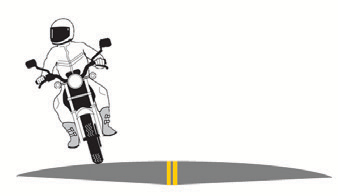
Section 7: Special Riding Situations
Section 7: Special Riding Situations
This Section Covers
- Crowned Roads – 7.1
- Work Zones – 7.2
- Tire Failure – 7.3
- Animals – 7.4
- Wind – 7.5
The following section offers some additional information on special riding situations you may encounter when riding a motorcycle.
7.1 – Crowned Roads

A road surface that is higher in the middle than at the sides is a crowned road. Use caution when going around curves to the left because ground clearance is reduced and the lean angle available will be less than on a flat road.
7.2 – Work Zones
Work zones present a hazard to all drivers but even more so for motorcycle riders. Lacking four-wheel stability, the motorcycle rider must reduce speed and be especially mindful of potential hazards.
The following are types of work zone road hazards and what to do if you encounter them:
- Sand or gravel on pavement – Slow down, don’t make sudden turns, brake lightly in a straight line. If you encounter long stretches of sand or gravel, downshift and keep your speed steady.
- Scored or grooved pavement – Keep your head and eyes up. Go slow, don’t fight the handlebars. Keep a steady throttle.
- Oil or fresh tar – Avoid if possible. Go slow and avoid sudden moves.
- Rippled and uneven temporary pavement – Scan the pavement and pick the smoothest line. Cross slowly and carefully. Be aware of the difference in height between lanes that have been repaved and those awaiting to be paved – crossing into the higher lane at high speeds and a narrow angle could cause you to lose control.
- Objects in the road – Scan well ahead. Go around object, if possible. Increase your following distance to allow maneuvering room.
7.3 – Tire Failure
You will seldom hear a tire go flat. If the motorcycle starts handling differently, it may be a tire failure. This can be dangerous. You must be able to tell from the way the motorcycle reacts. If one of your tires suddenly loses air, react quickly to keep your balance. Pull off and check the tires.
If the front tire goes flat, the steering will feel “heavy.” A front-wheel flat is particularly hazardous because it affects your steering. You have to steer well to keep your balance.
If the rear tire goes flat, the back of the motorcycle may jerk or sway from side to side.
If either tire goes flat while riding:
- Hold handgrips firmly, ease off the throttle, and keep a straight course.
- If braking is required, however, gradually apply the brake of the tire that isn’t flat, if you are sure which one it is.
- When the motorcycle slows, edge to the side of the road, squeeze the clutch and stop.
7.4 – Animals

Dogs sometimes chase motorcycles. Once an approaching dog is spotted, slow down and downshift until the dog is near your motorcycle, then accelerate crisply away from the dog as it approaches. Keep control of your motorcycle, and look to where you want to go. Don’t kick at the dog because it will make controlling the motorcycle difficult.
Larger animals such as deer or elk present a different problem. These animals are unpredictable, and hitting one can be as harmful as colliding with another vehicle. Use more aggressive SEE maneuvers for additional time and space in areas where larger animals may be present. If one of these animals is encountered on or near the roadway, the only reliable action is to stop before reaching it. Then wait until the animal leaves or move past the animal at walking speed.
7.5 – Wind
Strong, steady winds can affect you and your motorcycle. The effects can occur anywhere and often happen in open areas or mountainous terrain.
Wind turbulence can occur when you share the road with large vehicles like trucks, buses and recreational vehicles.
To respond to wind gusts or windblasts:
- Lean into the wind by applying forward pressure on the handgrip nearest the windblast.
- Move away from other vehicles as they approach or as you pass.
- Maximize the space cushion around you.
- Find a safe place to park until conditions improve if the wind becomes too dangerous.
Test Your Knowledge
- When riding over scored or grooved pavement in a work zone:
- Look down to see changes in the road surface.
- Keep your head and eyes up.
- Stay to the left side of the lane.
- If you are chased by a dog:
- Stop until the animal loses interest.
- Approach the animal slowly, then accelerate briskly away from the dog as it approaches.
- Swerve around the animal.
Answers
- B – see the section "Work Zones"
- B – see the section "Animals"